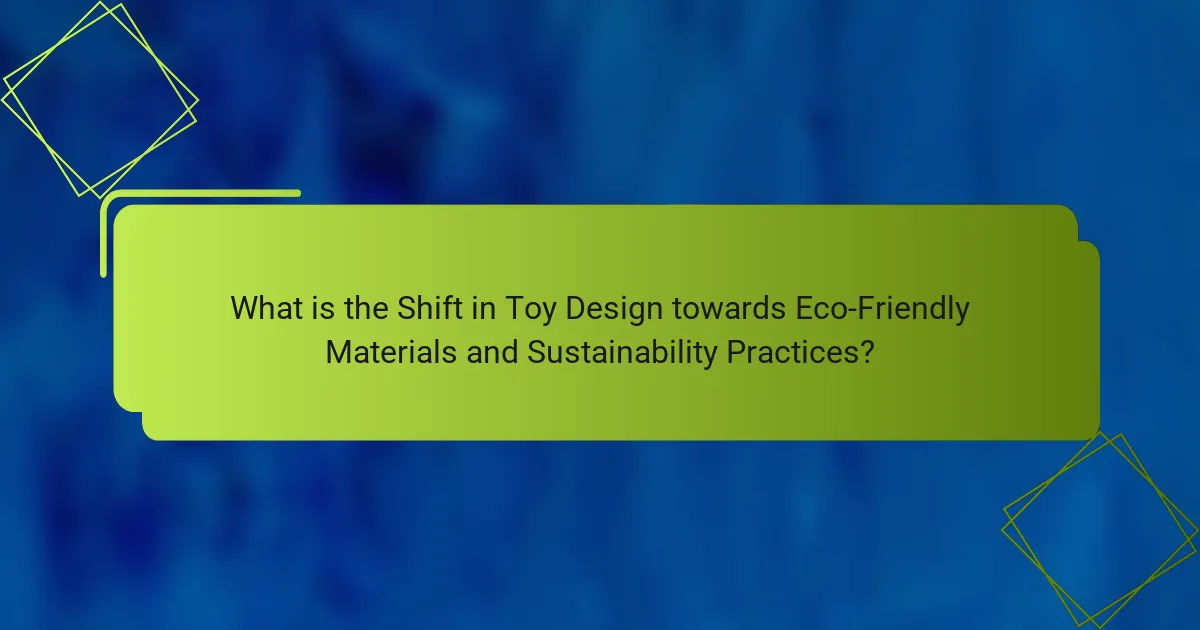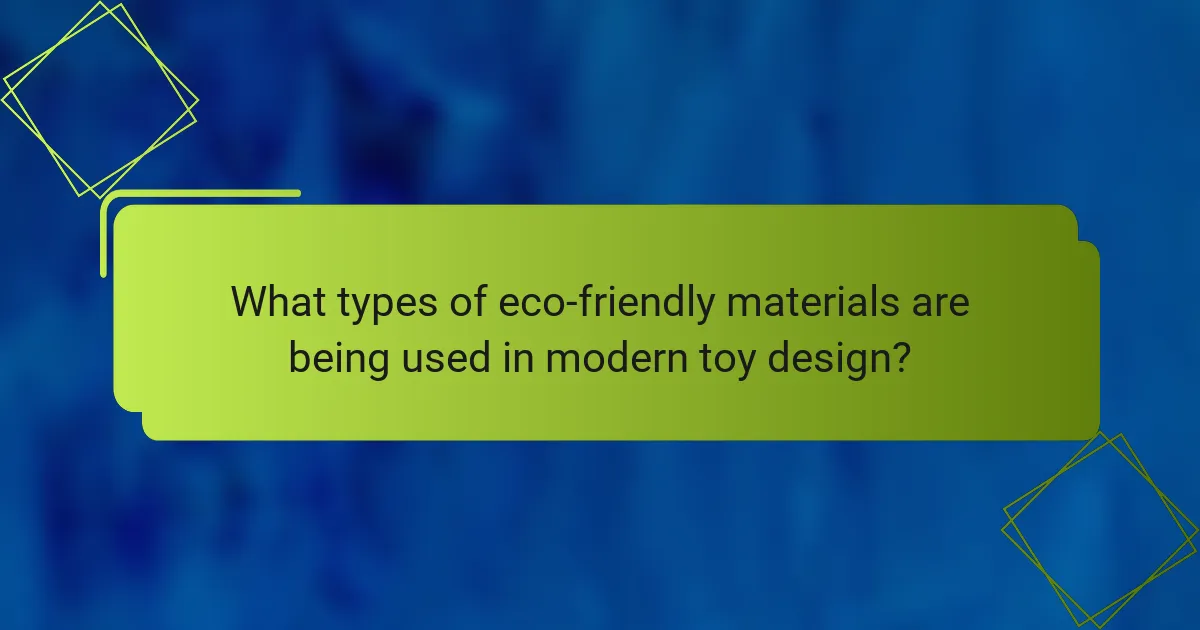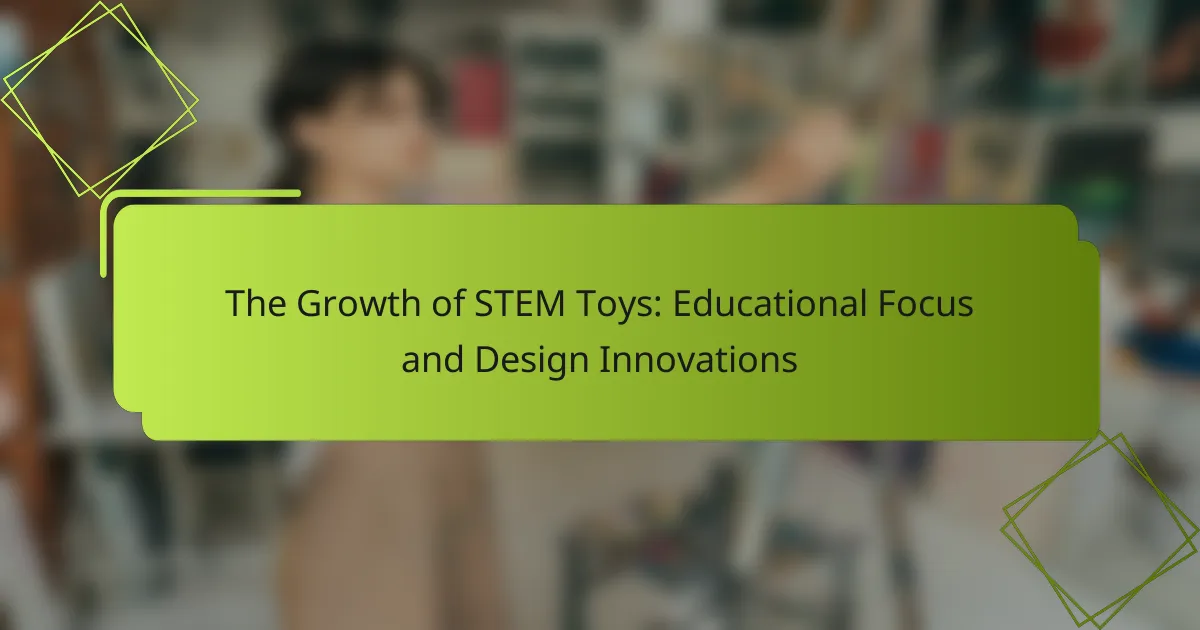
What is the Shift in Toy Design towards Eco-Friendly Materials and Sustainability Practices?
The shift in toy design towards eco-friendly materials and sustainability practices focuses on reducing environmental impact. Manufacturers are increasingly using biodegradable materials, such as bamboo and recycled plastics. This change aims to minimize waste and pollution associated with traditional toy production. For instance, studies indicate that plastic toys contribute significantly to landfill waste. Additionally, brands are adopting sustainable manufacturing processes to lower carbon footprints. This includes using renewable energy sources and reducing water consumption. Consumers are also driving this trend by demanding greener products. Research shows that 70% of parents prefer eco-friendly toys for their children. Overall, the toy industry is evolving to meet sustainability goals while appealing to environmentally conscious consumers.
How has the toy industry evolved in its approach to sustainability?
The toy industry has increasingly prioritized sustainability in recent years. Companies are now focusing on eco-friendly materials for toy production. This includes using recycled plastics and biodegradable components. Many brands have committed to reducing their carbon footprints. For instance, LEGO announced plans to use sustainable materials by 2030. Additionally, some toy manufacturers are implementing take-back programs for recycling. The trend reflects growing consumer demand for environmentally responsible products. Research indicates that 70% of parents prefer sustainable toys for their children. This evolution demonstrates a significant shift towards sustainable practices in the toy industry.
What historical factors have influenced this shift in toy design?
The shift in toy design has been influenced by several historical factors. The rise of environmental awareness in the 1960s and 1970s prompted consumers to seek sustainable products. Legislation, such as the Consumer Product Safety Act of 1972, increased scrutiny on toy safety and materials. Economic recessions led manufacturers to reconsider production costs and materials. The emergence of educational theories emphasized the importance of play in child development, influencing design choices. Globalization expanded access to materials, allowing for innovative designs. Social movements advocating for children’s rights also shaped the demand for safe and eco-friendly toys. These factors collectively drove the transition toward eco-friendly materials and sustainable practices in toy design.
How do consumer preferences impact eco-friendly toy design?
Consumer preferences significantly influence eco-friendly toy design. As awareness of environmental issues grows, consumers seek sustainable products. This demand drives manufacturers to prioritize eco-friendly materials and production methods. For example, toys made from recycled plastics or organic materials are increasingly popular. Studies show that 70% of parents prefer toys that are safe for the environment. This preference encourages brands to innovate in design and sourcing. Additionally, consumer feedback shapes the features and aesthetics of eco-friendly toys. Companies that align with consumer values often see increased sales and brand loyalty.
Why is the use of eco-friendly materials important in toy design?
The use of eco-friendly materials is important in toy design because it reduces environmental impact. Eco-friendly materials minimize pollution and waste during production. They also promote sustainability by using renewable resources. Toys made from these materials are safer for children and the planet. Research indicates that plastic waste from toys contributes significantly to global pollution. According to a study by the Ellen MacArthur Foundation, transitioning to sustainable materials can reduce plastic pollution by up to 80%. Additionally, eco-friendly toys often have a lower carbon footprint. This shift in design aligns with growing consumer demand for sustainable products.
What are the environmental benefits of using sustainable materials?
Sustainable materials provide significant environmental benefits. They reduce resource depletion by using renewable resources. This practice lowers carbon emissions compared to traditional materials. For example, bamboo grows rapidly and absorbs more carbon dioxide. Sustainable materials also minimize waste through recyclability and biodegradability. According to the Environmental Protection Agency, recycling can save energy and reduce landfill use. Additionally, using sustainable materials fosters biodiversity by reducing habitat destruction. Overall, sustainable materials contribute to a healthier ecosystem.
How do eco-friendly materials affect the safety of toys?
Eco-friendly materials enhance the safety of toys by reducing harmful chemicals. Traditional toys often contain toxic substances like phthalates and lead. Eco-friendly materials, such as organic cotton and bamboo, are free from these harmful additives. Studies show that toys made from natural materials pose a lower risk of chemical exposure. For instance, the American Academy of Pediatrics recommends toys made from non-toxic materials for children’s safety. Additionally, eco-friendly toys are less likely to break into small, hazardous pieces. This reduces choking hazards associated with conventional plastic toys. Overall, using eco-friendly materials contributes to safer play environments for children.

What types of eco-friendly materials are being used in modern toy design?
Biodegradable plastics, organic cotton, and sustainably sourced wood are key eco-friendly materials used in modern toy design. Biodegradable plastics break down naturally, reducing landfill waste. Organic cotton is grown without harmful pesticides, making it safer for children and the environment. Sustainably sourced wood comes from responsibly managed forests, ensuring minimal ecological impact. Other materials include recycled plastics, which help reduce the demand for new resources. Additionally, natural rubber is utilized for its durability and renewability. These materials reflect a growing commitment to sustainability in the toy industry.
What are the most common sustainable materials used in toys?
The most common sustainable materials used in toys include wood, organic cotton, bamboo, and recycled plastics. Wood is often sourced from sustainable forests, ensuring minimal environmental impact. Organic cotton is grown without synthetic pesticides or fertilizers, promoting healthier ecosystems. Bamboo is a fast-growing grass that requires less water and no chemicals to thrive. Recycled plastics help reduce waste by repurposing materials that would otherwise contribute to pollution. Collectively, these materials reflect a growing commitment to eco-friendly practices in toy manufacturing.
How do biodegradable materials compare to traditional plastics?
Biodegradable materials decompose naturally and reduce environmental impact compared to traditional plastics. Traditional plastics can take hundreds of years to break down. They contribute significantly to pollution and landfill waste. In contrast, biodegradable materials typically break down within months to a few years, depending on conditions. This rapid decomposition helps minimize long-term environmental damage. Studies show that biodegradable plastics can reduce greenhouse gas emissions during production. Additionally, they often use renewable resources, unlike fossil fuel-based traditional plastics. This shift promotes sustainability in industries, including toy design.
What role do recycled materials play in toy manufacturing?
Recycled materials play a crucial role in toy manufacturing by reducing environmental impact. They help decrease the reliance on virgin resources. This shift supports sustainability practices in the industry. Many toy manufacturers now use recycled plastics and metals. For example, companies like LEGO have committed to using sustainable materials by 2030. Using recycled materials lowers carbon emissions during production. It also minimizes waste in landfills. Additionally, toys made from recycled materials can be just as safe and durable as those made from new materials.
How do manufacturers ensure the sustainability of their toy products?
Manufacturers ensure the sustainability of their toy products by utilizing eco-friendly materials and implementing responsible production practices. They often source biodegradable or recycled materials, reducing environmental impact. Many companies adopt life cycle assessments to evaluate the sustainability of their products from creation to disposal. They also prioritize non-toxic paints and finishes to enhance safety and environmental friendliness. Additionally, manufacturers may engage in ethical labor practices, ensuring fair treatment of workers. Some brands participate in take-back programs, encouraging consumers to return used toys for recycling. Certifications like FSC (Forest Stewardship Council) indicate responsible sourcing of wood materials. These practices collectively contribute to a more sustainable toy industry.
What certifications or standards are important for sustainable toys?
Important certifications for sustainable toys include ASTM F963, EN71, and ISO 8124. ASTM F963 is a standard in the United States that ensures toy safety and non-toxicity. EN71 is the European standard for toy safety, covering various hazards. ISO 8124 provides international guidelines for toy safety, focusing on the health and safety of children. Additionally, certifications like Forest Stewardship Council (FSC) and Cradle to Cradle indicate sustainable sourcing and design practices. These certifications help consumers identify toys that meet strict environmental and safety criteria.
How can companies improve their supply chain for sustainability?
Companies can improve their supply chain for sustainability by adopting eco-friendly practices and materials. This includes sourcing sustainable raw materials, which reduces environmental impact. Implementing energy-efficient processes can lower carbon emissions during production. Companies should also optimize logistics to minimize transportation distances, thus reducing fuel consumption. Collaborating with suppliers committed to sustainability fosters a responsible supply chain. Additionally, adopting circular economy principles, such as recycling and reusing materials, enhances sustainability. According to a 2021 McKinsey report, sustainable supply chains can reduce costs by up to 15% while improving brand reputation.

What are the challenges faced in implementing sustainable practices in toy design?
Implementing sustainable practices in toy design faces several challenges. One major challenge is the sourcing of eco-friendly materials. Many sustainable materials are not as readily available as conventional plastics. This can lead to increased costs and longer production times. Another challenge is consumer demand for lower prices. Many consumers prioritize cost over sustainability, making it difficult for brands to justify higher prices for eco-friendly toys. Additionally, there is a lack of industry standards for what constitutes a sustainable toy. This can lead to confusion and inconsistencies in marketing claims. Lastly, manufacturers often face technical limitations in creating durable and safe toys from sustainable materials. These challenges hinder the widespread adoption of sustainable practices in the toy industry.
What obstacles do manufacturers encounter when sourcing eco-friendly materials?
Manufacturers encounter several obstacles when sourcing eco-friendly materials. One significant challenge is the higher cost of eco-friendly materials compared to conventional options. According to a 2020 report by the Ellen MacArthur Foundation, sustainable materials can be up to 30% more expensive. Another obstacle is the limited availability of these materials in the market. Many manufacturers struggle to find reliable suppliers who can provide consistent quantities of eco-friendly inputs. Additionally, the complexity of sourcing can lead to longer lead times, affecting production schedules. Manufacturers also face challenges in meeting regulatory standards for eco-friendly certifications. This can complicate the sourcing process and increase time and costs. Furthermore, there is often a lack of consumer awareness regarding the benefits of eco-friendly materials, which can impact demand and profitability. These obstacles collectively hinder manufacturers in their efforts to transition to sustainable practices in toy design.
How do cost implications affect the adoption of sustainable practices?
Cost implications significantly influence the adoption of sustainable practices in toy design. Higher initial costs for eco-friendly materials deter some manufacturers. Many companies prioritize lower production costs to maximize profit margins. This often leads to a preference for traditional materials over sustainable options. Additionally, consumers may resist higher prices associated with sustainable toys. Market research indicates that price sensitivity is a key barrier to purchasing eco-friendly products. For instance, a study by Nielsen found that 66% of global consumers are willing to pay more for sustainable brands, yet many still opt for cheaper alternatives. Thus, while cost implications can hinder adoption, a segment of consumers actively seeks sustainable options when prices are competitive.
What consumer misconceptions exist regarding eco-friendly toys?
Consumers often believe that eco-friendly toys are less durable than conventional toys. This misconception arises from the assumption that natural materials cannot withstand wear and tear. In reality, many eco-friendly toys are designed to be just as sturdy, using high-quality sustainable materials. Another common belief is that eco-friendly toys are significantly more expensive. While some eco-friendly options can be pricier, many affordable alternatives exist that do not compromise on quality. Additionally, consumers may think that eco-friendly toys lack variety and creativity. However, the market for these toys has expanded, offering a wide range of designs and functionalities. Finally, some consumers assume that eco-friendly toys are not as safe as traditional toys. In fact, many eco-friendly toys are made without harmful chemicals, making them safer for children.
How can consumers support sustainable toy design?
Consumers can support sustainable toy design by choosing products made from eco-friendly materials. Selecting toys crafted from biodegradable or recycled materials reduces environmental impact. Supporting brands that prioritize sustainability in their manufacturing processes encourages responsible practices. Consumers can also look for certifications indicating sustainability, such as FSC or organic labels. Engaging in community initiatives that promote sustainable toy use raises awareness. Avoiding single-use plastics in toy packaging further supports eco-friendly practices. Research shows that consumer demand for sustainable products influences manufacturers to adopt greener practices. The 2021 Global Sustainability Study found that 66% of consumers are willing to pay more for sustainable brands.
What are some tips for choosing eco-friendly toys for children?
Choose toys made from natural materials like wood, organic cotton, or recycled plastic. These materials are safer for children and the environment. Look for non-toxic paints and finishes to ensure safety. Check for certifications like FSC (Forest Stewardship Council) or GOTS (Global Organic Textile Standard). These labels indicate sustainable practices. Avoid toys with excessive packaging to reduce waste. Opt for toys that encourage creativity and open-ended play. Research brands that prioritize sustainability in their production processes.
How can consumers advocate for sustainability in the toy industry?
Consumers can advocate for sustainability in the toy industry by choosing eco-friendly products. They can research brands that prioritize sustainable materials and ethical manufacturing practices. Supporting companies that use recycled or biodegradable materials is essential. Consumers should also engage with brands through social media, urging them to adopt greener practices. Participating in community initiatives focused on sustainability raises awareness. Additionally, consumers can educate others about the environmental impacts of traditional toys. By making informed purchasing decisions, they can influence market trends. Research shows that 70% of consumers consider sustainability in their buying choices, highlighting the potential for change.
The main entity of the article is the shift in toy design towards eco-friendly materials and sustainability practices. The article outlines the growing trend among manufacturers to adopt biodegradable materials and sustainable production methods to reduce environmental impact and meet consumer demand for greener products. It discusses historical influences on this shift, the types of eco-friendly materials being used, and the challenges manufacturers face in sourcing these materials. Additionally, it highlights the role of consumer preferences and misconceptions regarding eco-friendly toys, providing actionable tips for consumers to support sustainable toy design.



